电子提单规则(中英文)
- 格式:docx
- 大小:24.42 KB
- 文档页数:6
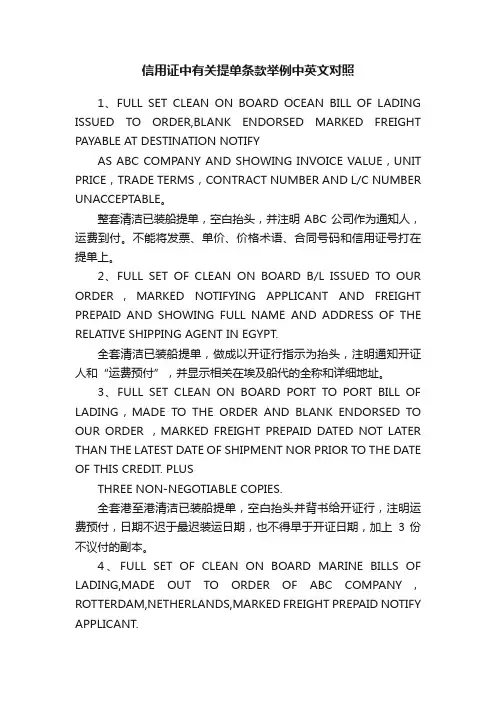
信用证中有关提单条款举例中英文对照1、FULL SET CLEAN ON BOARD OCEAN BILL OF LADING ISSUED TO ORDER,BLANK ENDORSED MARKED FREIGHT PAYABLE AT DESTINATION NOTIFYAS ABC COMPANY AND SHOWING INVOICE VALUE,UNIT PRICE,TRADE TERMS,CONTRACT NUMBER AND L/C NUMBER UNACCEPTABLE。
整套清洁已装船提单,空白抬头,并注明 ABC 公司作为通知人,运费到付。
不能将发票、单价、价格术语、合同号码和信用证号打在提单上。
2、FULL SET OF CLEAN ON BOARD B/L ISSUED TO OUR ORDER,MARKED NOTIFYING APPLICANT AND FREIGHT PREPAID AND SHOWING FULL NAME AND ADDRESS OF THE RELATIVE SHIPPING AGENT IN EGYPT.全套清洁已装船提单,做成以开证行指示为抬头,注明通知开证人和“运费预付”,并显示相关在埃及船代的全称和详细地址。
3、FULL SET CLEAN ON BOARD PORT TO PORT BILL OF LADING,MADE TO THE ORDER AND BLANK ENDORSED TO OUR ORDER ,MARKED FREIGHT PREPAID DATED NOT LATER THAN THE LATEST DATE OF SHIPMENT NOR PRIOR TO THE DATE OF THIS CREDIT. PLUSTHREE NON-NEGOTIABLE COPIES.全套港至港清洁已装船提单,空白抬头并背书给开证行,注明运费预付,日期不迟于最迟装运日期,也不得早于开证日期,加上3 份不议付的副本。
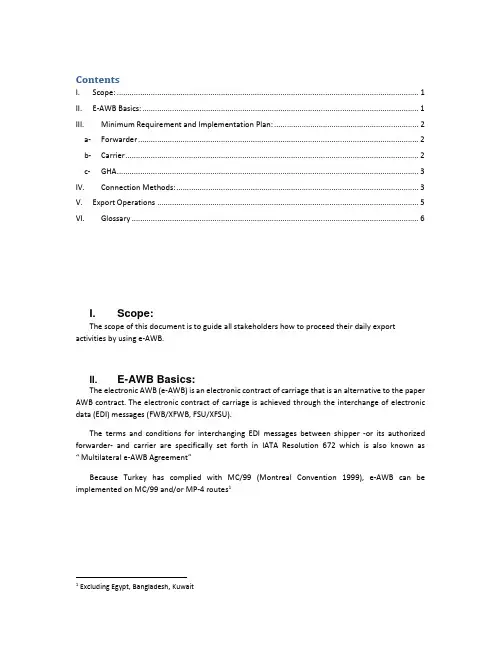
ContentsI. Scope: (1)II. E-AWB Basics: (1)III. Minimum Requirement and Implementation Plan: (2)a- Forwarder (2)b- Carrier (2)c- GHA (3)IV. Connection Methods: (3)V. Export Operations (5)VI. Glossary (6)I. Scope:The scope of this document is to guide all stakeholders how to proceed their daily export activities by using e-AWB.II. E-AWB Basics:The electronic AWB (e-AWB) is an electronic contract of carriage that is an alternative to the paper AWB contract. The electronic contract of carriage is achieved through the interchange of electronic data (EDI) messages (FWB/XFWB, FSU/XFSU).The terms and conditions for interchanging EDI messages between shipper -or its authorized forwarder- and carrier are specifically set forth in IATA Resolution 672 which is also known as “ Multilateral e-AWB Agreement”Because Turkey has complied with MC/99 (Montreal Convention 1999), e-AWB can be implemented on MC/99 and/or MP-4 routes11 Excluding Egypt, Bangladesh, KuwaitIII. Minimum Requirement and Implementation Plan:In order to implement e-AWB in operation processes, all stakeholders need to meet some requirements which are explained below.a-Forwarder•Forwarder needs to sign IATA Multilateral agreement and comply with its requirement (both legal and technical)•Forwarder shall be able to send/receive messages to/from Airline.o Messages to be sent: FWB, FHLo Messages to be received: FMA, FNA, FSUThese messages can be either in IMP or XML format•Messages which are provided by the forwarder need to meet desired data quality.This is important because airline considers the content of the message instead ofdocuments and which affects operation processes.•Forwarder needs to provide CSD (Consignment Security Declaration) information in FWB message, so airline can proceed e-CSD•Forwarder needs to ensure that organizational change management in their processes has been done properly i.e. Trainingb-Carrier•Carrier needs to sign IATA Multilateral agreement and comply with its requirement (both legal and technical)•Carrier shall send an activation notice to forwarder•Carrier shall be able to send/receive messages to/from forwarder and GHAo Messages to be sent: FWB, FHL, FMA, FNA, FSUo Messages to be received: FWB, FHLThese messages can be either in IMP or XML format•Carrier needs to ensure data quality of the messages which are provided by the forwarder is in desired level. To achieve enough quality, carrier tracks and fixesany potential problem with corresponding business partner by making regulardiscussions•Preferably, carrier needs to be able to print out MAWB and CSD documents according to FWB message which is provided by the forwarder, if it is needed •If a GHA operates w/h operations on behalf of carrier at origin point, carrier needs to copy FWB message to GHA which is provided by the forwarder•Carrier needs to ensure that e-AWB can be applied to MC/99 and/or MP-4 routes.There can be some station where e-AWB is not accepted even if the specificcountries comply with MC/99.•Carrier needs to ensure that organizational change management in their processes has been done properly i.e. Trainingc-GHA•GHA needs to be able to send/receive messages to/from Airlineo Messages to be sent : FWB, FHL, FSU, FMAo Messages to be received: FWB, FHL, FSU•Preferably, GHA needs to be able to print out MAWB and CSD documents according to FWB message which is provided by the carrier, if it is needed •GHA needs to ensure that organizational change management in their processes has been done properly i.e. Training•GHA needs to ensure that data quality of messages meets desired requirements.i.e. FSU messagesIV. Connection Methods:Each stakeholder connects to other with different connection methods which depend on various indicators:•Size of the stakeholdero Operationalo Commercial•Operational structure•TechnologyGeneral Connection Methods for exchanging messagesIn connection between stakeholders there are 2 common standards which are IATA Cargo XML and CIMP. XML offers several advantages in comparison with the CIMP. By using xml messages, stakeholders are able to transmit more detailed data in messages which allows them to remove paper from the processes more easily. Only C-IMP version 32 or higher can be used for exchanging messages.Exchanging messages by Web portalA web portal may be provided by different parties (Airlines, CCS…). There are most common two types of Web portals, one of them is carrier web portal which is provided by Airlines and the other one is multi-carrier web portal which is provided by CCS. Freight forwarders choose one of these options according to their house indicators to exchange messages with airlines. Such a web portal, generate and receive the messages (FWB, FSU-RCS, XML). It also provides access to Cargo receipt and allows printing paper AWBMessages which need to be copiedIf GHA is handling w/h operations on behalf of carrier at that specific airport then Airline needs to copy some messages to GHA. By this way GHA is able to know whether messages which are sent by the forwarder processed by airline or not.V. Export OperationsNote: ECC code can be applied where EAP code is not used between airline and forwarderVI. Glossary- CCS : Cargo Community System – (Value Added Network for Cargo)- CSD : Consignment Security Declaration- CIMP : IATA’s Cargo Interchange Message Procedure Manual- CXML : IATA’s new XML message format- EDI : Electronic Data Interchange- E-CSD : Electronic Consignment Security Declaration- ECC : Special handling code for a shipment using an electronic air waybill – stands for ‘Electronically Concluded Cargo Contract- EAP : E-freight Consignment with Accompanying Documents- EAW: E-freight Consignment with No Accompanying Documents- FF : Freight Forwarder- FFM : Airline Flight Manifest Message- FFR : AWB space Allocation Request “Freight Booking Request Message”.- FHL : Consolidation List Message (House Manifest data message) or House Waybill details- FMA : Message Acknowledgement Message- FNA : Error Message- FSA : Status Answer Message- FSR : Status Request Message- FSU : Status Update Message- FSU/BKD : Consignment booked on a specific flight- FSU/RCS : Consignment received from shipper or agent- FSU/DEP : Consignment departed on a specific flight- FWB :Air Waybill Data Message- FZB :House Waybill Data Message- GHA : Ground Handling Agent- IATA : International Air Transport Association- MAN : Consignment manifested on a specific flight- SOP : Standard Operational Procedure。
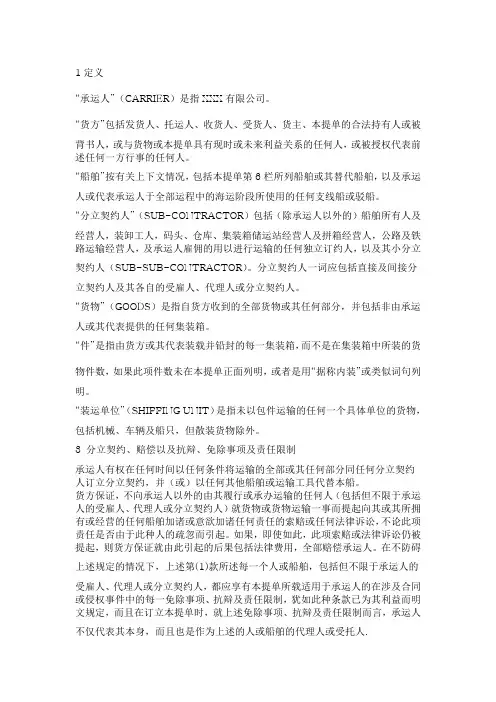
1定义“承运人”(CARRIER)是指XXX有限公司。
“货方”包括发货人、托运人、收货人、受货人、货主、本提单的合法持有人或被背书人,或与货物或本提单具有现时或未来利益关系的任何人,或被授权代表前述任何一方行事的任何人。
“船舶”按有关上下文情况,包括本提单第6栏所列船舶或其替代船舶,以及承运人或代表承运人于全部运程中的海运阶段所使用的任何支线船或驳船。
“分立契约人”(SUB-CONTRACTOR)包括(除承运人以外的)船舶所有人及经营人,装卸工人,码头、仓库、集装箱储运站经营人及拼箱经营人,公路及铁路运输经营人,及承运人雇佣的用以进行运输的任何独立订约人,以及其小分立契约人(SUB-SUB-CONTRACTOR)。
分立契约人一词应包括直接及间接分立契约人及其各自的受雇人、代理人或分立契约人。
“货物”(GOODS)是指自货方收到的全部货物或其任何部分,并包括非由承运人或其代表提供的任何集装箱。
“件”是指由货方或其代表装载并铅封的每一集装箱,而不是在集装箱中所装的货物件数,如果此项件数未在本提单正面列明,或者是用“据称内装”或类似词句列明。
“装运单位”(SHIPPING UNIT)是指未以包件运输的任何一个具体单位的货物,包括机械、车辆及船只,但散装货物除外。
3 分立契约、赔偿以及抗辩、免除事项及责任限制承运人有权在任何时间以任何条件将运输的全部或其任何部分同任何分立契约人订立分立契约,并(或)以任何其他船舶或运输工具代替本船。
货方保证,不向承运人以外的由其履行或承办运输的任何人(包括但不限于承运人的受雇人、代理人或分立契约人)就货物或货物运输一事而提起向其或其所拥有或经营的任何船舶加诸或意欲加诸任何责任的索赔或任何法律诉讼,不论此项责任是否由于此种人的疏忽而引起。
如果,即使如此,此项索赔或法律诉讼仍被提起,则货方保证就由此引起的后果包括法律费用,全部赔偿承运人。
在不防碍上述规定的情况下,上述第(1)款所述每一个人或船舶,包括但不限于承运人的受雇人、代理人或分立契约人,都应享有本提单所载适用于承运人的在涉及合同或侵权事件中的每一免除事项、抗辩及责任限制,犹如此种条款已为其利益而明文规定,而且在订立本提单时,就上述免除事项、抗辩及责任限制而言,承运人不仅代表其本身,而且也是作为上述的人或船舶的代理人或受托人.4 承运人的责任港到港运输如果填注本提单正面第6、7、8栏,而不填注第4、5、9栏,本提单便是港到港契约。

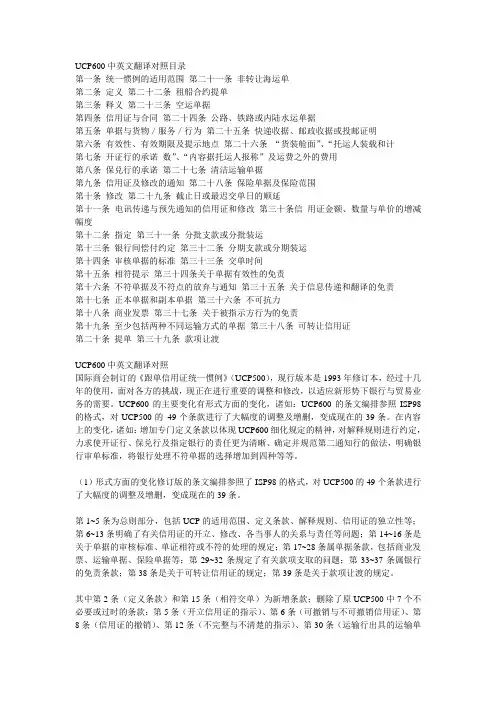
UCP600中英文翻译对照目录第一条统一惯例的适用范围第二十一条非转让海运单第二条定义第二十二条租船合约提单第三条释义第二十三条空运单据第四条信用证与合同第二十四条公路、铁路或内陆水运单据第五条单据与货物/服务/行为第二十五条快递收据、邮政收据或投邮证明第六条有效性、有效期限及提示地点第二十六条“货装舱面”、“托运人装载和计第七条开证行的承诺数”、“内容据托运人报称”及运费之外的费用第八条保兑行的承诺第二十七条清洁运输单据第九条信用证及修改的通知第二十八条保险单据及保险范围第十条修改第二十九条截止日或最迟交单日的顺延第十一条电讯传递与预先通知的信用证和修改第三十条信用证金额、数量与单价的增减幅度第十二条指定第三十一条分批支款或分批装运第十三条银行间偿付约定第三十二条分期支款或分期装运第十四条审核单据的标准第三十三条交单时间第十五条相符提示第三十四条关于单据有效性的免责第十六条不符单据及不符点的放弃与通知第三十五条关于信息传递和翻译的免责第十七条正本单据和副本单据第三十六条不可抗力第十八条商业发票第三十七条关于被指示方行为的免责第十九条至少包括两种不同运输方式的单据第三十八条可转让信用证第二十条提单第三十九条款项让渡UCP600中英文翻译对照国际商会制订的《跟单信用证统一惯例》(UCP500),现行版本是1993年修订本,经过十几年的使用,面对各方的挑战,现正在进行重要的调整和修改,以适应新形势下银行与贸易业务的需要。
UCP600的主要变化有形式方面的变化,诸如:UCP600的条文编排参照ISP98的格式,对UCP500的49个条款进行了大幅度的调整及增删,变成现在的39条。
在内容上的变化,诸如:增加专门定义条款以体现UCP600细化规定的精神,对解释规则进行约定,力求使开证行、保兑行及指定银行的责任更为清晰、确定并规范第二通知行的做法,明确银行审单标准,将银行处理不符单据的选择增加到四种等等。
(1)形式方面的变化修订版的条文编排参照了ISP98的格式,对UCP500的49个条款进行了大幅度的调整及增删,变成现在的39条。
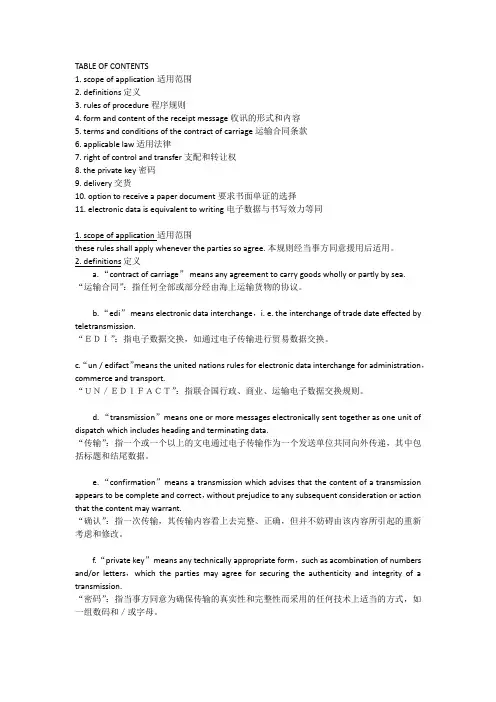
TABLE OF CONTENTS1. scope of application适用范围2. definitions 定义3. rules of procedure程序规则4. form and content of the receipt message收讯的形式和内容5. terms and conditions of the contract of carriage运输合同条款6. applicable law适用法律7. right of control and transfer支配和转让权8. the private key密码9. delivery交货10. option to receive a paper document要求书面单证的选择11. electronic data is equivalent to writing电子数据与书写效力等同1. scope of application适用范围these rules shall apply whenever the parties so agree. 本规则经当事方同意援用后适用。
2. definitions 定义a. “contract of carriage” means any agreement to carry goods wholly or partly by sea.“运输合同”:指任何全部或部分经由海上运输货物的协议。
b. “edi” means electronic data interchange,i. e. the interchange of trade date effected by teletransmission.“EDI”:指电子数据交换,如通过电子传输进行贸易数据交换。
c. “un / edifact”means the united nations rules for electronic data interchange for administration,commerce and transport.“UN/EDIFACT”:指联合国行政、商业、运输电子数据交换规则。
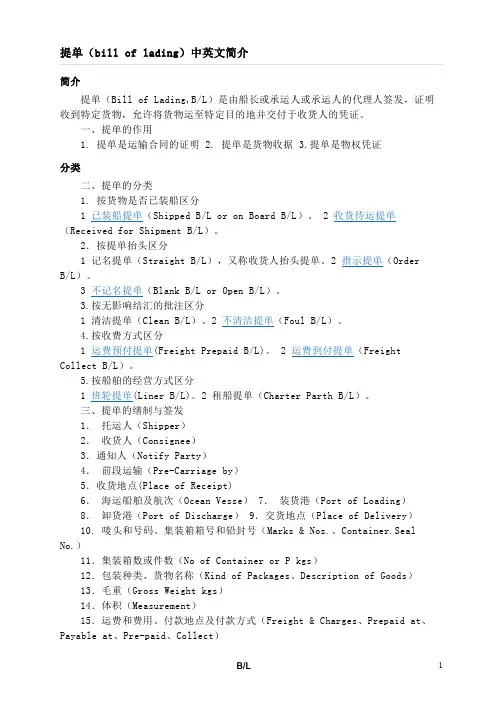
简介提单(Bill of Lading,B/L)是由船长或承运人或承运人的代理人签发,证明收到特定货物,允许将货物运至特定目的地并交付于收货人的凭证。
一、提单的作用1. 提单是运输合同的证明2. 提单是货物收据3.提单是物权凭证分类二、提单的分类1. 按货物是否已装船区分1 已装船提单(Shipped B/L or on Board B/L)。
2 收货待运提单(Received for Shipment B/L)。
2.按提单抬头区分1 记名提单(Straight B/L),又称收货人抬头提单。
2 指示提单(Order B/L)。
3 不记名提单(Blank B/L or Open B/L)。
3.按无影响结汇的批注区分1 清洁提单(Clean B/L)。
2 不清洁提单(Foul B/L)。
4.按收费方式区分1 运费预付提单(Freight Prepaid B/L)。
2 运费到付提单(Freight Collect B/L)。
5.按船舶的经营方式区分1 班轮提单(Liner B/L)。
2 租船提单(Charter Parth B/L)。
三、提单的缮制与签发1.托运人(Shipper)2.收货人(Consignee)3.通知人(Notify Party)4.前段运输(Pre-Carriage by)5.收货地点(Place of Receipt)6.海运船舶及航次(Ocean Vesse) 7.装货港(Port of Loading)8.卸货港(Port of Discharge) 9.交货地点(Place of Delivery)10. 唛头和号码、集装箱箱号和铅封号(Marks & Nos.、Container.Seal No.)11.集装箱数或件数(No of Container or P kgs)12.包装种类、货物名称(Kind of Packages、Description of Goods)13.毛重(Gross Weight kgs)14.体积(Measurement)15.运费和费用、付款地点及付款方式(Freight & Charges、Prepaid at、Payable at、Pre-paid、Collect)16.提单号和正本提单份数(B/L No.、No.of Original B(s)/L)17.签单地点和日期(Place and Date of Issue)18.代表承运人签字(Signed for the Carrier)区别四、B/L与D/O的区别B/L:BILL OF LADING提单,是货物的物权凭证。
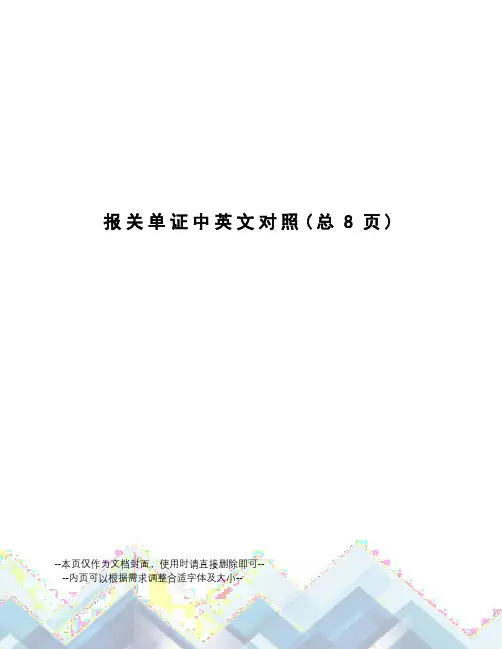
报关单证中英文对照(总8页)--本页仅作为文档封面,使用时请直接删除即可----内页可以根据需求调整合适字体及大小--(4)进口成交方式如果是:①FOB,按公式“CIF=FOB+I+F”转换成CIF(C—COST,I—INSURANCE,F—FREIGHT),在运费栏填写运费率或单价或总价。
②CFR,按公式“CIF=CFR+I”转换成CIF,运费栏免填。
③CIF,运费栏、保费栏免填。
(5)出口成交方式如果是:①CIF,按公式“FOB=CIF―I―F”转换成FOB,在运费栏填写运费率或单价或总价。
②CFR,按公式“FOB=CFR―F”转换成FOB,在运费栏填写运费率或单价或总价。
③FOB,运费栏、保费栏免填。
二.报关英语常用词汇import进口 export出口importn & export corporation(Corp.)importn & export business(enterprise entitled to do import and export business) export drawback出口退税nimportn & export licenceprocessing with imported(supplied) materials进(来)料加工nbuyer买方 seller卖方The buyer requests his bank to issue a letter of credit in favor of the seller.goods(import& export goods , All import and export goods shall be subject to Customs examination)cargo (bulk cargo, cargo in bulk, air cargo, sea cargo, bonded cargo, cargo-owner What cargo is inside the container?The cargo is now released.Commodity(commodity inspection)merchandise泛指商品,不特指某一商品article(smuggled goods and articles, inward and outward goods and articles)luggage 行李物品postal items 邮递物品You don’t have to pay duty on personal belongings, but the other one is subject to duty.means of transport(conveyance)运输工具(vessel, aircraft, train, vehicle):All inward and outward means of transport shall be subject to Customs control on arriving in or departing from the Customs territory.ocean vessel船名packing(bag袋, bale包, bottle, coil圈,case, crate板条箱,dozen, package件:total packages合计件数, piece, roll, set, unit辆,台,单位,drum桶, carton纸箱, wooden cases木箱, pallet托盘, container ,in bulk)weight重量gross weight毛重 net weight净重 tare皮重quantity数量:The minimum quantity of an order for the goods is 500 cases. description of goods货名name and specifications of commodity品名及规格type类型mode (term)of trade贸易方式name of trading country贸易国date of importation进口日期value价值total value of the contract commercial value, duty-paying valueThe duty-paying value of an import item shall be its normal CIF price and the duty-paying value of an export item shall be its FOB price, minus the export duty.The duty-paying value of an inward or outward article shall be fixed by the Customs. price价格 unit price单价 total price总价 total amount总价consignor发货人 consignee收货人While the examination is being carried out, the consignee of the import goods or the consignor of the export goods shall be present and responsible for moving the goods, opening and restoring the packingDeclaration of import goods shall be made to the Customs by the consignee within 14 days of the declaration of the arrival of the means of transport; declaration of export goods shall be made by the consignor 24 hours prior to the loading unless otherwise approved by the Customs. 进口货物的收货人应当自运输工具申报进境之日起14日内,出口货物的发货人除海关特准的外应当在货物运抵海关监管区后装货的24小时以前,向海关申报。
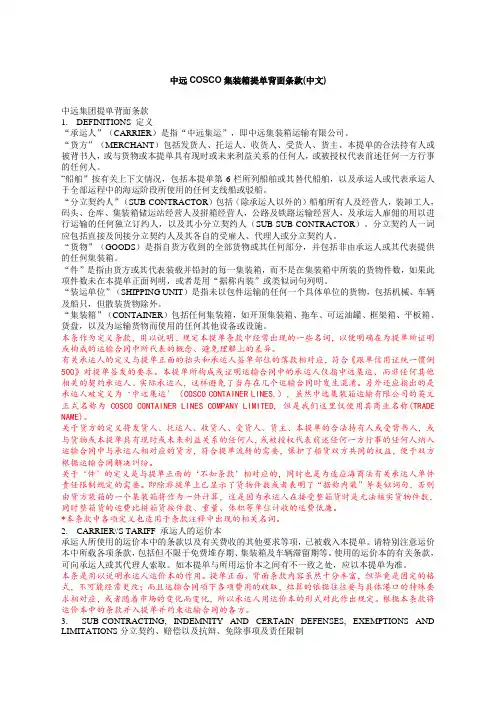
中远COSCO集装箱提单背面条款(中文)中远集团提单背面条款1. DEFINITIONS 定义“承运人”(CARRIER)是指“中远集运”,即中远集装箱运输有限公司。
“货方”(MERCHANT)包括发货人、托运人、收货人、受货人、货主、本提单的合法持有人或被背书人,或与货物或本提单具有现时或未来利益关系的任何人,或被授权代表前述任何一方行事的任何人。
“船舶”按有关上下文情况,包括本提单第6栏所列船舶或其替代船舶,以及承运人或代表承运人于全部运程中的海运阶段所使用的任何支线船或驳船。
“分立契约人”(SUB-CONTRACTOR)包括(除承运人以外的)船舶所有人及经营人,装卸工人,码头、仓库、集装箱储运站经营人及拼箱经营人,公路及铁路运输经营人,及承运人雇佣的用以进行运输的任何独立订约人,以及其小分立契约人(SUB-SUB-CONTRACTOR)。
分立契约人一词应包括直接及间接分立契约人及其各自的受雇人、代理人或分立契约人。
“货物”(GOODS)是指自货方收到的全部货物或其任何部分,并包括非由承运人或其代表提供的任何集装箱。
“件”是指由货方或其代表装载并铅封的每一集装箱,而不是在集装箱中所装的货物件数,如果此项件数未在本提单正面列明,或者是用“据称内装”或类似词句列明。
“装运单位”(SHIPPING UNIT)是指未以包件运输的任何一个具体单位的货物,包括机械、车辆及船只,但散装货物除外。
“集装箱”(CONTAINER)包括任何集装箱,如开顶集装箱、拖车、可运油罐、框架箱、平板箱、货盘,以及为运输货物而使用的任何其他设备或设施。
本条作为定义条款,用以说明、规定本提单条款中经常出现的一些名词,以便明确在为提单所证明或构成的运输合同中所代表的概念、避免理解上的差异。
有关承运人的定义与提单正面的抬头和承运人签单部位的落款相对应,符合《跟单信用证统一惯例500》对提单签发的要求。
本提单所构成或证明运输合同中的承运人仅指中远集运、而非任何其他相关的契约承运人、实际承运人,这样避免了当存在几个运输合同时发生混淆。
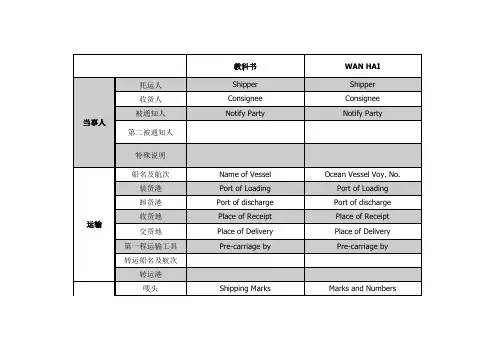

中远COSCO集装箱提单背面条款(中文)中远集团提单背面条款1. DEFINITIONS 定义“承运人”(CARRIER)是指“中远集运”,即中远集装箱运输有限公司。
“货方”(MERCHANT)包括发货人、托运人、收货人、受货人、货主、本提单的合法持有人或被背书人,或与货物或本提单具有现时或未来利益关系的任何人,或被授权代表前述任何一方行事的任何人。
“船舶”按有关上下文情况,包括本提单第6栏所列船舶或其替代船舶,以及承运人或代表承运人于全部运程中的海运阶段所使用的任何支线船或驳船。
“分立契约人”(SUB-CONTRACTOR)包括(除承运人以外的)船舶所有人及经营人,装卸工人,码头、仓库、集装箱储运站经营人及拼箱经营人,公路及铁路运输经营人,及承运人雇佣的用以进行运输的任何独立订约人,以及其小分立契约人(SUB-SUB-CONTRACTOR)。
分立契约人一词应包括直接及间接分立契约人及其各自的受雇人、代理人或分立契约人。
“货物”(GOODS)是指自货方收到的全部货物或其任何部分,并包括非由承运人或其代表提供的任何集装箱。
“件”是指由货方或其代表装载并铅封的每一集装箱,而不是在集装箱中所装的货物件数,如果此项件数未在本提单正面列明,或者是用“据称内装”或类似词句列明。
“装运单位”(SHIPPING UNIT)是指未以包件运输的任何一个具体单位的货物,包括机械、车辆及船只,但散装货物除外。
“集装箱”(CONTAINER)包括任何集装箱,如开顶集装箱、拖车、可运油罐、框架箱、平板箱、货盘,以及为运输货物而使用的任何其他设备或设施。
本条作为定义条款,用以说明、规定本提单条款中经常出现的一些名词,以便明确在为提单所证明或构成的运输合同中所代表的概念、避免理解上的差异。
有关承运人的定义与提单正面的抬头和承运人签单部位的落款相对应,符合《跟单信用证统一惯例500》对提单签发的要求。
本提单所构成或证明运输合同中的承运人仅指中远集运、而非任何其他相关的契约承运人、实际承运人,这样避免了当存在几个运输合同时发生混淆。
中远COSCO集装箱提单背面条款(中文)1. DEFINITIONS 定义"Carrier" means COSCO container lines company limited."Merchant" includes the consignor, the shipper, the receiver, the consignee, the owner of the Goods, the lawful holder or endorsee of this Bill of Lading, or any other person having any present or future interest in the Goods or this Bill of Lading, or anyone authorized to act on behalf of any of the foregoing."Vessel", where the context so admits, includes the Vessel named in Box 6 of this Bill of Lading or any substitute therefor, and any feeder vessel, lighter or barge used by or on behalf of the Carrier in connection with any seaborne leg of the carriage."Sub-contractor" includes owners and operators of vessels (other than the Carrier), stevedores, terminal, warehouse, depot and groupage operators, road and rail transport operators and any independent contractor employed by the Carrier in the performance of the carriage and any sub-sub-contractor thereof. The expression Sub-contractor shall include direct and indirect Sub-contractors and their respective servants, agents or Sub-contractors."Goods" means the whole or any part of the cargo received from the Merchant and includes any Container not supplied by or on behalf of the Carrier."Package" means each Container which is stuffed and sealed by or on behalf of the Merchant, and not the items packed in such Container if the number of such items is not indicated on the front of this Bill of Lading or is indicated by the terms such as "Said to Contain" or similar expressions."Shipping Unit" means any physical unit of cargo not shipped in a package, including machinery, vehicles and boats, except goods shipped in bulk."Container" includes any Container, open top, trailer, transportable tank, flat rack, platform, pallet, and any other equipment or device used for or in connection with the transportation of the Goods.“承运人”(CARRIER)是指“中远集运”,即中远集装箱运输有限公司。
RECEIVED in external apparent good order and condition except as otherwise noted. The total number of packages or units stuffed in the container, the description of the goods and the weights shown in this Bill of Lading are furnished by the Merchants, and which the carrier has no reasonable means of checking and is not a part of this Bill of Lading contract. The carrier has issued the number of Bills of Lading stated below, all of this tenor and date, one of the original Bills of lading must be surrendered and endorsed or signed against the delivery of the shipment and whereupon any other original Bills of Lading shall be void. The Merchants agree to be bound by the terms and conditions of this Bill of Lading as if each had personally signed this Bill of Lading.SEE clause 4 on the back of this Bill of Lading (Terms continued on the back hereof, plaease read carefully) *Applicable Only When Document Used as a Combined Transport Bill of Lading.中远集提单背面条款FORM98051. DEFINITIONS 定义"Carrie r" means COSCO container lines company limited. “承运人”(CARRIER)是指“中远集运”,即中远集装箱运输有限公司。
提单中英文合同范文提单(Bill of Lading)提货单简称。
在海上货物运输中均,航空运输收到承运的货物后,签发给托运人的书面单证。
其中正本2-3份,副本若干份。
收货人凭正本提单向货运目的地的运输部门提货。
ShipperGuangzhouArts ; Craft Crop.Guangzhou, ChinaConsigneeOrderNotify Address Joseph Smith ; SonsXXX StreetSouthampton, BritainVessel:M. V. WULINPort of loading:WhampoaB/L No. S0003FAR EAST ENTERPRISING CO(H.K)LTDHONG KONGBILL OF LOADINGDirect or with transshipmentsSHIPPED on board in apparent good order and condition (unless otherwise indicated) the goods or packages specified herein and to be discharged at the mentioned port of discharge or as near thereto as the vessel may safely get and be always afloat.The weight, measure, marks, numbers, quality, contents and value, being particulars furnished by the Shipper.The Shipper, Consignee and the Holder of this Bill of loading hereby expressly accept and agree to all printed, written or stamped provisions, exceptions and conditions of this Bill of loading, including those on the back hereof.Port of discharge: Southamption Freight payable at:Number of original Bs/L:THREE (3)Marks and numbers:Number and kind of package:description of goodsGross weight(kg)Measurement (M)SOUTHAMPTON JSS1/2525 cartonsPorcelain Figures300kgs PARTICULARS FURNISHED BY SHIPPERS ORIGINALFreight and chargesFreight PaidIN WITNESS where of the Carrier or his Agents has signed the above stated number of Bill of lading all of this tenor and date, one of which being accomplished the others to stand void.Terms and Conditions as per back hereofPlace and date of issue: Whampoa25 April 1986Signed (for the master) by:托运人:中国、广州广州工艺品公司收货人:通知地址:英国南安普顿XXX约瑟夫.史密斯父子公司船名:武林号装货港:黄埔提单号:S0003香港华夏企业有限公司提单直运或转运本提单所列外表情况良好的货物或包件(另有说明者除外)已装在下列船上并将在下列卸货港或该轮所能完全到达并保持浮泊的附近地点卸货。
提单中英文对照(全)1] Reference number (提单号):2] Name of vessel / Voyage number (船名/航次):3] E T A (预计到港日):4] Load Port (起运港):5] Tranship Port (if any) (中转港) :6] Discharge Port (卸货港):7] Term of this shipment。
( CY/CY ) :8] Proper shipping name under IMDG code (运输品名):9] Proper chemical name ( If applicable ) (化学品名):10]Quantity and type of inner and outer package(内外包装类型及数量) :11]Gross weight (KGS)(货物毛重) :12]Nett weight (KGS) (货物净重):13]Number, size and type of container (箱型,箱数):14]Class / UN number (危险品类别/国际编码):15]Label, subsidiary risk label (危标):16]Packing group (包装类别):17]Flash point in unit deg。
C ( If applicable )(闪点) :18]MPA group :19]EMS ( Emergency schedule ):20]Marine pollutant ( Yes / No ) (海洋污染):船公司SO文件的英文简单解释Booking number:订舱号码Vessel:船名Voyage:航次CY Closing DATE:截柜日期,截关日closing Date/Time:截柜日期SI CUT OFF date/time:截提单补料日期/时间Expiry date:有效期限,到期日期Sailing date:航行日期 / 船离开港口的日期ETA(ESTIMATED TIME OF ARRIVAL):预计到达时间,到港日(船到目的港日期) ETD(ESTIMATED TIME OF DELIVERY):开船日(起运港船离港日期)ETC(ESTIMATED TIME OF CLOSING):截关日Port of loading(POL):装货港Full Delivery Pickup Terminal:提重柜码头Empty Cntainer Depot:交空柜场站Loading port:装货港From City:起运地EXP(export):出口Final destination:目的港,最终目的地Place of Delivery(POD)或To City:目的地,交货地Port of discharge:卸货港Discharge port:卸货港Load Port:卸货港Dry:干的/不含液体或湿气cargo type:货物种类container number:集装箱号码container:集装箱specific cargo container:特种货物集装箱Number of container:货柜数量container Size:货柜尺寸CU。
各个国家对提单的要求 (2)1. 美洲 (2)1.1墨西哥MEXICAO (2)1.2多米尼加共和国DOMINICAN REPUBILC (2)1.3厄瓜多尔(ECUADOR) (2)1.4巴拿马PANAMA (3)1.5波多黎各PUERTO RICA (3)1.6哥伦比亚(COLOMBIA) (3)1.7古巴(CUBA) (3)1.8委内瑞拉(VENEZUELA) (3)1.9阿根廷(ARGENTINA)和巴拉圭(PARAGUAY) (3)1.10秘鲁(PERU)和智利(CHILE) (3)1.11巴西(BRAZIL) (3)1.12中美洲(MIDDLE AMERICA) (4)2. 亚洲 (4)2.1韩国 (4)2.2马来西亚、印度尼西亚、束埔寨 (4)2.3印度尼西亚 (5)2.4南亚国家India, Pakistan, Sri Lanka and Maldive Islands (5)2.5斯里兰卡 (5)2.6新加坡 (5)2.7伊朗 (5)2.8土耳其 (6)2.9沙特阿拉伯 (6)2.10约旦 (6)2.11巴林 (7)2.12伊拉克 (7)2.13塞浦路斯 (7)2.14卢旺达 (7)2.15尼日尔(Niger),马里(Mali)和上沃尔特(Upper V olta) (7)2.16阿拉伯地区 (7)2.17科威特 (7)2.18斯里兰卡、孟加拉、印度、尼伯尔、巴林、阿根廷、西班牙、墨西哥 (8)3.非洲 (8)4.澳洲 (9)4.1澳大利亚 (9)4.2新西兰 (9)各个国家对提单的要求1.美洲(1)都必须提供商业发票,必须显示收货人的详细资料,包括电话和传真号码;(2)指定货提单显示运费,必须用英文对日用品做详情的描述;(3)如果是私人物品,必须在提单上显示CPF和护照号码,还须显示NCM-CODE的前四位数字(4)如果是拖盘,必须显示详细的件数在提单上;必须在提单上显示详细的包装名称和数量。
Received in apparent good order and condition unless otherwise indicated herein, the goods, or the container(s) o package(s) said to contain the goods described herein for transportation from the place of receipt or the port of loading to the place of delivery or the port of discharge to be carried subject to the terms and conditions hereof. One of the original bill of lading duly endorsed must be surrendered in exchange for the goods or delivery order.In accepting this bill of lading, the merchant agrees to be bound by all the stipulations, exceptions, terms and conditions on the face and back hereof. Whether written, typed, stamped or printed as fully as if signed by the merchant any local custom or privilege to the contrary notwithstanding.In witness whereof the number of original bills of lading stated below have been signed, one of which being accomplished the other(s) to be void.See terms on reverse承运人已收到符合提单规定的表面状况良好的货物(除本提单另有说明),此货物为承运人接收运输货物一栏所示的全部货物或据称内装相应货物的集装箱或其它货物包装,将从货物接收地或装船港运往卸货港或货物交付地并受本提单的所有条款之约束。
TABLE OF CONTENTS1. scope of application适用范围2. definitions 定义3. rules of procedure程序规则4. form and content of the receipt message收讯的形式和内容5. terms and conditions of the contract of carriage运输合同条款6. applicable law适用法律7. right of control and transfer支配和转让权8. the private key密码9. delivery交货10. option to receive a paper document要求书面单证的选择11. electronic data is equivalent to writing电子数据与书写效力等同1. scope of application适用范围these rules shall apply whenever the parties so agree. 本规则经当事方同意援用后适用。
2. definitions 定义a. “contract of carriage” means any agreement to carry goods wholly or partly by sea.“运输合同”:指任何全部或部分经由海上运输货物的协议。
b. “edi” means electronic data interchange,i. e. the interchange of trade date effected by teletransmission.“EDI”:指电子数据交换,如通过电子传输进行贸易数据交换。
c. “un / edifact”means the united nations rules for electronic data interchange for administration,commerce and transport.“UN/EDIFACT”:指联合国行政、商业、运输电子数据交换规则。
d. “transmission”means one or more messages electronically sent together as one unit of dispatch which includes heading and terminating data.“传输”:指一个或一个以上的文电通过电子传输作为一个发送单位共同向外传递,其中包括标题和结尾数据。
e. “confirmation”means a transmission which advises that the content of a transmission appears to be complete and correct,without prejudice to any subsequent consideration or action that the content may warrant.“确认”:指一次传输,其传输内容看上去完整、正确,但并不妨碍由该内容所引起的重新考虑和修改。
f. “private key” means any technically appropriate form,such as acombination of numbers and/or letters,which the parties may agree for securing the authenticity and integrity of a transmission.“密码”:指当事方同意为确保传输的真实性和完整性而采用的任何技术上适当的方式,如一组数码和/或字母。
g. “holder” means the party who is entitled to the rights described in article 7(a) by virtue of its possession of a valid private key.“持有人”:指享有根据本规则第七条a款所列权利并拥有有效密码的一方。
h. “electronic monitoring system”means the device by which a computer system can be examined for the transactions that it recorded,such as a trade data log or an audit trail.“电子监督系统”:指用于检查记载一笔交易的计算机系统的手段,如贸易数据日志或跟踪检查。
i. “electronic storage”means any temporary, intermediate or permanent storage of electronic data including the primary and the back-up storageof such data.“电子储藏”:指电子数据的临时、中期或永久性储藏,包括此数据的替代或原始储藏。
3. rules of procedure程序规则a. when not in conflict with these rules,the uniform rules of conduct for interchange of trade data by teletransmission,1987(UNCID)shallgovern the conduct between the parties.在不与本规则冲突的情况下,1987年“电子传输贸易数据交换行动统一规则”将指导本规则当事方的行动。
b. the edi under these rules should conform with the relevantun/edifact standards. however, the parties may use any other method of trade data interchange acceptable to all of the users.本规则项下的电子数据交换应符合联合国行政、商业、运输电子数据交换规则的有关标准。
c. unless otherwise agreed,the document format for the contract of carriage shall conform to the layout key or compatible national standard for bills of lading.除另有协议外,运输合同的文件格式应符合联合国编排图例表,或与此相仿的国内提单标准。
d. unless otherwise agreed,a recipient of a transmission is not authorised to act on a transmission unless he has sent a confirmation.除另有协议外,一项传输的接收人除非在其接收后发回确认,否则无权根据该传输内容行事。
e. in the event of a dispute arising between the parties as to the data actually transmitted,an electronic monitoring system may be used to verify the data received. data concerning other transactions not related to the data in dispute are to be considered as trade secrets and thus not available for examination. if such data are unavoidably revealed as part of the examination of the electronic monitoring system,they must be treated as confidential and not released to any outside party or used forany other purpose.因当事方之间发生由于实际传送数据所引起的争议时,可利用电子监督系统证实接收的数据。
有关争议数据以外的、涉及其它交易的数据应视为贸易机密可不予检查。
由于作为电子监督系统检查的一部分而不可避免地暴露非争议数据,当事方应信守机密,并不予向外界披露或挪作它途。
f. any transfer of rights to the goods shall be considered to be private information,and shall notbe released to any outside party not connected to the transport or clearance of the goods.任何所有权的转让都应视为私有情报,不应向与该货物运输或结关无关的任何其它方披露。
4. form and content of the receipt message收讯的形式和内容a. the carrier,upon receiving the goods from the shipper,shall give notice of the receipt of the goods to the shipper by a message at the electronic address specified by the shipper.承运人在接收到发货人提供的货物之后应按照发货人说明的电子地址给予发货人一接收到货物的电讯通知。
b. this receipt message shall include:该收讯应包括:i. the name of the shipper;发货人姓名;ii. the description of the goods, with any representations and reservations, in the same tenor as would be required if a paper bill of lading were issued;货物说明,包括描述和保留,如同为签发一个书面提单所需求的一样;iii. the date and place of the receipt of the goods;接收货物的地点和日期;iv. a reference to the carrier's terms and conditions of carriage;and 援引承运人的运输条款;和v. the private key to be used in subsequent transmissions. 用于日后传输的密码。